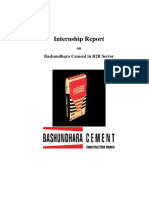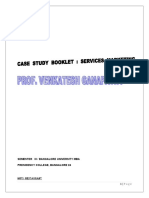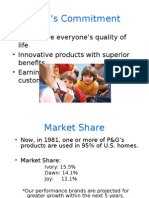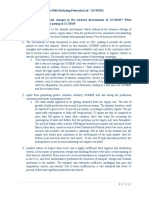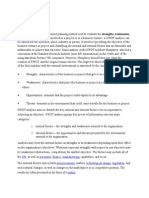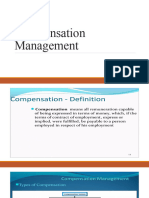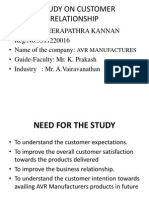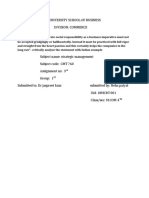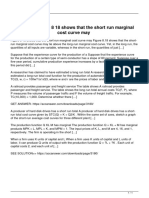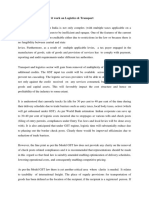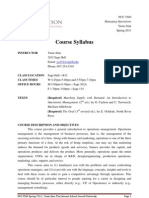Professional Documents
Culture Documents
A Method Study On Implementation of Material Requirement Planning (MRP-I) in Sample Bicycle Manufacturing Industry
Original Title
Copyright
Share this document
Did you find this document useful?
Is this content inappropriate?
Report this DocumentCopyright:
A Method Study On Implementation of Material Requirement Planning (MRP-I) in Sample Bicycle Manufacturing Industry
Copyright:
Volume 4, Issue 3, March – 2019 International Journal of Innovative Science and Research Technology
ISSN No:-2456-2165
A Method Study on Implementation of Material
Requirement Planning (MRP-I) in Sample Bicycle
Manufacturing Industry
Vijay Prakash M Ananth Selvakumar Zeba Jihan
School of Management School of Management School of Management
SRM Institute of Science & SRM Institute of Science & SRM Institute of Science &
Technology Technology Technology
Chennai, India Chennai, India Chennai, India
Abstract:- Scheduling is the process that refers to inventory increase efficiency and productivity in
establishing the timing and use of resources involved in operations.
various operations within the organization. It relates to
efficient use of equipment and facility, human resources The inventory management is analyzed using Material
and materials. The problems faced due to absence of Requirement Planning also known as MRP-I. It is a system
scheduling in an organization are staff turnover, used for calculating the various materials and components
employee availability, covering of unusual periods of required for manufacturing a product. It consists of three
activity and so on. This paper highlights the problems phases namely: taking inventory of the materials and
an organization faces due to absence or low quality components on hand, identifying additional ones are needed
scheduling and how to overcome these. Michael J and then scheduling their production or purchase. It refers to
Brusco has subsequently developed a new heuristic the basic calculations used to determine component
based search on the simulated annealing algorithm, requirement from end product manufacturing.
which was to generate integer personnel schedules in
continuously operating organizations. The baseline of II. EXISTING PROBLEMS
any business is to achieve profitability and scheduling
has major impact on company’s profitability. The gaps A. Excess Inventory
in scheduling are chaos in operations, loss of credibility, Excess inventory occurs when inaccurate orders are
inefficient workflows and increased costs. The main aim made which leads to storage problems and also prevents
of this work is to nullify the gaps using scheduling tools from offering better products to customers.
and techniques and also to improve the revenue of the
organization. The data used for this analysis are B. Failure to Keep Track of Stock
primary data which were collected through interviews Tracking inventory with infrequent checks or using
and surveys. This analysis will help in identifying the manual process is not enough to manage the supply chain.
next level schedule in an organization. This analysis will Failing to keep close track of stock movement causes
help in taking scheduling in an organization to next accounting errors, resulting in added costs for the
level. organization.
Keywords:- Staff Turnover, Annealing Algorithm and C. Difficulty in Identifying Demand Patterns
Gaps. Changing demand can also be one of the biggest
challenges of SMBs, especially with ever-increasing and
I. INTRODUCTION changing product portfolios.
Scheduling is the process of arranging, controlling D. Low Product Turnover
and optimizing the work and workloads in a production Failure in tracking demand leads to a reduced product
process. It pertains to establish both the time and use of turnover due to fall in demand. Lower turnover leads to
resources within an organization. Under the operations excess inventory that result in requirement for bigger space
function namely manufacturing and services, scheduling in warehouse and increase in capital.
relates to use of equipment and facilities, the scheduling of
human activities, and receipt of materials. Allocation of the III. PURPOSE OF ANALYSIS
above parameters along with the inventory management
using forward and backward scheduling is done here. The This analysis is used to determine the quantity,
supervision of non-capitalized assets and stock items is components and sub components requirement to keep
major part in operations which is handled by inventory priorities updated for the production process through
management. Inventory management includes controlling Material Requirement Planning.
and overseeing of ordering inventory, storage of inventory
and controlling the amount of product ready for sale. So we
focus on inventory management which assists in managing
IJISRT19MA207 www.ijisrt.com 104
Volume 4, Issue 3, March – 2019 International Journal of Innovative Science and Research Technology
ISSN No:-2456-2165
A. Scheduling & Planning A. Bill of Material
The main objective of this analysis is to ensure MRP systems are dependent on identifying the
planning of all manufacturing processes, this scheduling of components, their interrelationships and the accurate
different job works or part production or purchase will quantities for production planning. Bill of Material is
minimize or remove any kind of idle time for machine and necessary for the system to be effective. MRP systems
workers. ensure that the Bill of Material is correct.
B. Inventory Management The bill of materials explains what, how, and where
Ensure the availability materials at the moment’s to buy the required materials, and also includes instructions
notice. This eliminates the need for manual processing and for how to assemble the product from the various parts
it is also able to carry out material orders with ease. ordered. All manufacturers who are building products,
regardless of their industry, always get started by creating a
C. Maintaining Priorities bill of materials.
It is used to keep priorities updated and valid. MRP
System is used to respond to the changes taking place in the This is because the bill of material pulls together all
daily environment, to reorganize priorities and also to keep sorts of product information that it has on several disciplines
plans current and viable. such as design and engineering, document control,
operations, manufacturing, purchasing and contract
D. Determine the Quantity and Timing of Material manufacturer will consume data contained within the BOM
Requirements record to get the job done right. In fact, engineers and
MRP is used to determine what to order, how much to manufactures of industry rely so heavily on special subsets
order, when to order and when to schedule delivery. called the engineering bill of materials (EBOM) and the
manufacturing bill of materials (MBOM). Business
E. Cost Reduction activities like parts sourcing, outsourcing and manufacturing
In correlation with inventory management, cost is are the main needs for executing BOM and so it is important
reduced significantly through a steady flow of inventory, to create a BOM that is well organized, correct and up-to-
holding and reduced untimely delivery cost and ultimately date.
brining more revenue into the operation.
B. Master Production Schedule
F. Production Optimization It specifies the quantities and times when products are
Material flow throughout the supply chain, equipment needed and thereby dictates when all the contributory
and employees are able to work at a much faster and production activities should happen. The master production
efficient rate. schedule also commonly referred to as the MPS is
effectively the plan that the company develops for
IV. MRP-I SYSTEM production, staffing, inventory, etc.
It has variety inputs of such as data, e.g. forecast
demand, production costs, inventory costs, etc and as
output a production plan detailing amounts to be produced,
staffing levels, etc for each of a number of time periods.
This production plan,
Operates at an aggregate level.
It is cost driven and attempts to meet the specified
requirements at minimum cost.
V. ANALYSIS AND INTERPRETATION
We conducted this analysis in bicycle manufacturing
industry. The below data is obtained from one of the
leading bicycle manufacturing company in India. Based on
that data’s we performed our analysis with the aid of tool
like MRP-I. We solved out the listed problems that helps
by means of minimizing the cost of production and time,
maximizing inventory utilization.
Fig 1:- MRP-I Systematic Diagram
IJISRT19MA207 www.ijisrt.com 105
Volume 4, Issue 3, March – 2019 International Journal of Innovative Science and Research Technology
ISSN No:-2456-2165
B. Handle bar
Inventory on Hand = 6760 units, Order Quantity =
3892 units, Lead Time = 1 month, Pre Order: None
Fig 2:- Product Structure
Order Inventory
Lead Time
Parts Quantity on Hand
(Month)
(Units) (Units)
BICYCLE 3276 1 4277
HANDLE
6760 1 3892
BAR
SEAT 6687 1 4042
WHEEL 8089 2 10,852
RIM 15,107 2 5874
TIRE 15,928 2 1036
Fig 4:- MRP Calculation of Handle Bar
FRAME 3276 1 2275
CHAIN 3433 2 4032 C. Seat
Inventory on Hand = 6687 units, Order Quantity =
Table 1:- Bill of Material 4042 units, Lead Time = 1 month, Pre Order: None
A. Bicycle
Inventory on Hand = 3276 units, Order Quantity =
4277 units, Lead Time = 1 month, Pre Order: Order place
on December (previous year) of 4277 units, to be delivered
in 1st month (January).
Fig 5:- MRP Calculation of Seat
D. Wheel (2)
Inventory on Hand = 10,852 units, Order Quantity =
Fig 3:- MRP Calculation of Bicycle 8059 units, Lead Time = 2 month
IJISRT19MA207 www.ijisrt.com 106
Volume 4, Issue 3, March – 2019 International Journal of Innovative Science and Research Technology
ISSN No:-2456-2165
Pre Order: Order place on December (previous year)
of 8089 units, to be delivered in 2nd month (February).
Fig 8:- MRP Calculation of Tire
G. Frame
Fig 6:- MRP Calculation of Wheel Inventory on Hand = 2275 units, Order Quantity =
3276 units, Lead Time = 1 month, Pre Order: None
E. Rim (2)
Inventory on Hand = 5874 units, Order Quantity =
15,107 units, Lead Time = 2 month, Pre Order: None
Fig 9:- MRP Calculation of Frame
Fig:- 7 MRP Calculation of Rim
H. Chain
F. Tire (2) Inventory on Hand = 4032 units, Order Quantity =
Inventory on Hand = 1136 units, Order Quantity = 3433 units, Lead Time = 2 month, Pre Order: None
15928 units, Lead Time = 2 month, Pre Order: None
IJISRT19MA207 www.ijisrt.com 107
Volume 4, Issue 3, March – 2019 International Journal of Innovative Science and Research Technology
ISSN No:-2456-2165
REFERENCES
[1]. Sagbanşua, L. and Alabay, M. (2010). An MRP Model
for Supply Chains. International Business Research,
3(4), pp.124-131.
[2]. Asis Sarkar, A Simple Case Study of Material
Requirement Planning, Issue 5, Volume 9, IOSR-
JMCE (Nov. Dec. 2013), PP 58-64.
[3]. Ade Isasya, MATERIAL REQUIREMENT
PLANNING ANALYSIS IN MICRO, SMALL AND
MEDIUM ENTERPRISE CASE STUDY:
GROOVELINE ‐ AN APPAREL OUTSOURCING
COMPANY, No. 3, Volume 4, Journal of Business
and Management 2015, PP 317-329.
[4]. Mahadevan B., Operations Management Theory and
Practice, Pearson Publication, 3rd Edition, 2015.
[5]. R. Panneerselvam, Production & operations
management, Prentice Hall India private limited, 2017.
Fig 10:- MRP Calculation of Chain
I. Observation
Fig 11:- Observation table (which month, what to order and
how much to order)
VI. CONCLUSION
Using MRP-I calculation the inventory scheduling is
calculated and planned on what quantity must be ordered
every month based on the availability of material in hand
and requirement. This calculation will help to increase the
profitability of company by means of decreasing the capital
cost in production of bicycles. It helps to maintain the
safety stock level for the purpose of round the clock
productions. This schedule planning method helps to place
the order of sub components and manage inventory
effectively. It can also be used to manage the inventory cost
and purchasing cost effectively. This will also help in
making a better decision in manufacturing of bicycles.
IJISRT19MA207 www.ijisrt.com 108
You might also like
- Domino's PizzaDocument14 pagesDomino's PizzaWyatt ThomasNo ratings yet
- Productivity and Reliability-Based Maintenance Management, Second EditionFrom EverandProductivity and Reliability-Based Maintenance Management, Second EditionNo ratings yet
- Disney stock valuation approachesDocument5 pagesDisney stock valuation approachesSiti Nabilah100% (1)
- Mahindra and Mahindra LimitedDocument8 pagesMahindra and Mahindra LimitedRothin ShawNo ratings yet
- SubwayDocument5 pagesSubwaykashfi350% (1)
- Servuction SystemDocument10 pagesServuction SystemMuhammad ShahbazNo ratings yet
- ONIDADocument4 pagesONIDARebecca Martin0% (1)
- Internship Report: On Bashundhara Cement in B2B SectorDocument32 pagesInternship Report: On Bashundhara Cement in B2B SectorAKASH CHANDRA PAULNo ratings yet
- Case 2 COO and Country Manager Job Selection Exercise KEEDocument1 pageCase 2 COO and Country Manager Job Selection Exercise KEEbamNo ratings yet
- A Study On Consumer Preferences For Mtr-RteDocument18 pagesA Study On Consumer Preferences For Mtr-RteMonalisa Barik0% (1)
- Challenges in The CaseDocument7 pagesChallenges in The Caseaslam khanNo ratings yet
- Leadership in TCS: 1. Motivating Yourself Will Motivate EmployeesDocument5 pagesLeadership in TCS: 1. Motivating Yourself Will Motivate EmployeesPrem GauravNo ratings yet
- Semester Iii / Bangalore University Mba Presidency College, Bangalore 24Document13 pagesSemester Iii / Bangalore University Mba Presidency College, Bangalore 24Aarya PatelNo ratings yet
- Porter Five Forces Analysis of Dr. Reddy's Laboratories in HealthcareDocument3 pagesPorter Five Forces Analysis of Dr. Reddy's Laboratories in HealthcareSaurabh NinaveNo ratings yet
- Marketing of Services Assignment Dated 04-06-2020Document2 pagesMarketing of Services Assignment Dated 04-06-2020RICHARD BAGENo ratings yet
- Britannia Logistics and Supply Chain ExcellenceDocument5 pagesBritannia Logistics and Supply Chain ExcellenceManjita NyachhyonNo ratings yet
- Sukumar - Mba Project-Consumer Perceoption in SagoSERVEDocument107 pagesSukumar - Mba Project-Consumer Perceoption in SagoSERVEPrasanna KumarNo ratings yet
- Rise of Temporary and Contingent Workers in HRDocument4 pagesRise of Temporary and Contingent Workers in HRsajid bhattiNo ratings yet
- ABC - Activity Based CostingDocument15 pagesABC - Activity Based CostingjpereztmpNo ratings yet
- BRM Report - Final (MBA-A) FDocument29 pagesBRM Report - Final (MBA-A) FhumaNo ratings yet
- Shoppers StopDocument23 pagesShoppers Stoptarannum0887No ratings yet
- Case StudiesDocument6 pagesCase StudiesAmar Singh SekhonNo ratings yet
- ES QuizDocument85 pagesES QuizVenkat Chowdary Yamparala100% (3)
- Sundram Fasteners ProfileDocument4 pagesSundram Fasteners ProfileSuriya Vinoth N100% (1)
- Group 4 SGVS Case Study - CA1Document5 pagesGroup 4 SGVS Case Study - CA1Yash ChaudharyNo ratings yet
- HAL HR StrategiesDocument3 pagesHAL HR StrategiesrohanagarwalNo ratings yet
- P&G's Plan to Improve Dawn and Joy Market ShareDocument21 pagesP&G's Plan to Improve Dawn and Joy Market ShareThomas DominicNo ratings yet
- Job Satisfaction at NestleDocument49 pagesJob Satisfaction at Nestlenaman100% (2)
- Understanding Process CostingDocument30 pagesUnderstanding Process CostingJehan MahmudNo ratings yet
- CRM ProcessDocument17 pagesCRM ProcessSaurabh Rinku86% (7)
- Service QualityDocument25 pagesService Qualityrk0522No ratings yet
- Misson & Vission of AirtelDocument23 pagesMisson & Vission of AirtelrameshsonuNo ratings yet
- BS Kanika Gradable Assignment 1 03 AprDocument3 pagesBS Kanika Gradable Assignment 1 03 AprRaj RishiNo ratings yet
- Zane Cycles Case, Video QuestionsDocument2 pagesZane Cycles Case, Video QuestionsVageesh KumarNo ratings yet
- Project Report On Job SatisfactionDocument120 pagesProject Report On Job SatisfactionSaad AnsariNo ratings yet
- Entrepreneurship ProjectDocument5 pagesEntrepreneurship Projectneha bagrechaNo ratings yet
- BA1722 Services MarketingDocument17 pagesBA1722 Services MarketingChandru SivaNo ratings yet
- Thakur's Journey from Tea Shop to Food Joint BusinessDocument11 pagesThakur's Journey from Tea Shop to Food Joint Businessush_grgNo ratings yet
- Business Environment Chapter 2Document24 pagesBusiness Environment Chapter 2Muneeb SadaNo ratings yet
- Feasiblity Study of Pizza HutDocument23 pagesFeasiblity Study of Pizza HutSid BhiseNo ratings yet
- MIS at Domino'sDocument3 pagesMIS at Domino'sPriyanka RawoolNo ratings yet
- Jumbo KingDocument25 pagesJumbo KingMadhumeeta BaukNo ratings yet
- WAGES TheoriesDocument25 pagesWAGES TheoriesSabitha Ansif100% (1)
- How Zomato Leveraged IT for Business GrowthDocument10 pagesHow Zomato Leveraged IT for Business GrowthAALIYA NASHATNo ratings yet
- Sip ProjectDocument126 pagesSip Projectsolanki_dipen2000100% (2)
- For SPSS AnalysisDocument22 pagesFor SPSS AnalysisUvasre SundarNo ratings yet
- SMDocument15 pagesSMneha100% (1)
- Meredith - Campaign Insights - PPT TestDocument1 pageMeredith - Campaign Insights - PPT TestNitesh KumarNo ratings yet
- POM - Royale Business SchoolDocument354 pagesPOM - Royale Business Schoolyadavboyz100% (1)
- Marketing of Services PPT ZomatoDocument15 pagesMarketing of Services PPT ZomatoSUMIT MITTALNo ratings yet
- W IPRODocument26 pagesW IPROSamad Bilgi50% (2)
- Decision Report: (Ethical Breach at Novacib Labs)Document4 pagesDecision Report: (Ethical Breach at Novacib Labs)Pratik SinghNo ratings yet
- Mastercard HRP ProjectDocument8 pagesMastercard HRP ProjectkritikaNo ratings yet
- Leadership in Client Service and Employee Education Case StudyDocument1 pageLeadership in Client Service and Employee Education Case StudyKumaresh Deenadayalan100% (2)
- Mapping The Compensation StrategyDocument3 pagesMapping The Compensation StrategyHRM1 Readings0% (1)
- HRM Case StudyDocument8 pagesHRM Case StudyJaymin PatelNo ratings yet
- Key Partners Key Activities Value Proposition Customer SegmentsDocument1 pageKey Partners Key Activities Value Proposition Customer SegmentsIshan BhatiaNo ratings yet
- Production Management BBA (II) MDU StudentsDocument112 pagesProduction Management BBA (II) MDU StudentsRishabh Gupta88% (8)
- Production Planning and ControlDocument34 pagesProduction Planning and ControlAkanksha RanjanNo ratings yet
- Formulation and Evaluation of Poly Herbal Body ScrubDocument6 pagesFormulation and Evaluation of Poly Herbal Body ScrubInternational Journal of Innovative Science and Research TechnologyNo ratings yet
- Comparatively Design and Analyze Elevated Rectangular Water Reservoir with and without Bracing for Different Stagging HeightDocument4 pagesComparatively Design and Analyze Elevated Rectangular Water Reservoir with and without Bracing for Different Stagging HeightInternational Journal of Innovative Science and Research TechnologyNo ratings yet
- Explorning the Role of Machine Learning in Enhancing Cloud SecurityDocument5 pagesExplorning the Role of Machine Learning in Enhancing Cloud SecurityInternational Journal of Innovative Science and Research TechnologyNo ratings yet
- A Review: Pink Eye Outbreak in IndiaDocument3 pagesA Review: Pink Eye Outbreak in IndiaInternational Journal of Innovative Science and Research TechnologyNo ratings yet
- Design, Development and Evaluation of Methi-Shikakai Herbal ShampooDocument8 pagesDesign, Development and Evaluation of Methi-Shikakai Herbal ShampooInternational Journal of Innovative Science and Research Technology100% (3)
- Studying the Situation and Proposing Some Basic Solutions to Improve Psychological Harmony Between Managerial Staff and Students of Medical Universities in Hanoi AreaDocument5 pagesStudying the Situation and Proposing Some Basic Solutions to Improve Psychological Harmony Between Managerial Staff and Students of Medical Universities in Hanoi AreaInternational Journal of Innovative Science and Research TechnologyNo ratings yet
- A Survey of the Plastic Waste used in Paving BlocksDocument4 pagesA Survey of the Plastic Waste used in Paving BlocksInternational Journal of Innovative Science and Research TechnologyNo ratings yet
- Electro-Optics Properties of Intact Cocoa Beans based on Near Infrared TechnologyDocument7 pagesElectro-Optics Properties of Intact Cocoa Beans based on Near Infrared TechnologyInternational Journal of Innovative Science and Research TechnologyNo ratings yet
- Auto Encoder Driven Hybrid Pipelines for Image Deblurring using NAFNETDocument6 pagesAuto Encoder Driven Hybrid Pipelines for Image Deblurring using NAFNETInternational Journal of Innovative Science and Research TechnologyNo ratings yet
- Cyberbullying: Legal and Ethical Implications, Challenges and Opportunities for Policy DevelopmentDocument7 pagesCyberbullying: Legal and Ethical Implications, Challenges and Opportunities for Policy DevelopmentInternational Journal of Innovative Science and Research TechnologyNo ratings yet
- Navigating Digitalization: AHP Insights for SMEs' Strategic TransformationDocument11 pagesNavigating Digitalization: AHP Insights for SMEs' Strategic TransformationInternational Journal of Innovative Science and Research TechnologyNo ratings yet
- Hepatic Portovenous Gas in a Young MaleDocument2 pagesHepatic Portovenous Gas in a Young MaleInternational Journal of Innovative Science and Research TechnologyNo ratings yet
- Review of Biomechanics in Footwear Design and Development: An Exploration of Key Concepts and InnovationsDocument5 pagesReview of Biomechanics in Footwear Design and Development: An Exploration of Key Concepts and InnovationsInternational Journal of Innovative Science and Research TechnologyNo ratings yet
- Automatic Power Factor ControllerDocument4 pagesAutomatic Power Factor ControllerInternational Journal of Innovative Science and Research TechnologyNo ratings yet
- Formation of New Technology in Automated Highway System in Peripheral HighwayDocument6 pagesFormation of New Technology in Automated Highway System in Peripheral HighwayInternational Journal of Innovative Science and Research TechnologyNo ratings yet
- Drug Dosage Control System Using Reinforcement LearningDocument8 pagesDrug Dosage Control System Using Reinforcement LearningInternational Journal of Innovative Science and Research TechnologyNo ratings yet
- The Effect of Time Variables as Predictors of Senior Secondary School Students' Mathematical Performance Department of Mathematics Education Freetown PolytechnicDocument7 pagesThe Effect of Time Variables as Predictors of Senior Secondary School Students' Mathematical Performance Department of Mathematics Education Freetown PolytechnicInternational Journal of Innovative Science and Research TechnologyNo ratings yet
- Mobile Distractions among Adolescents: Impact on Learning in the Aftermath of COVID-19 in IndiaDocument2 pagesMobile Distractions among Adolescents: Impact on Learning in the Aftermath of COVID-19 in IndiaInternational Journal of Innovative Science and Research TechnologyNo ratings yet
- Securing Document Exchange with Blockchain Technology: A New Paradigm for Information SharingDocument4 pagesSecuring Document Exchange with Blockchain Technology: A New Paradigm for Information SharingInternational Journal of Innovative Science and Research TechnologyNo ratings yet
- Perceived Impact of Active Pedagogy in Medical Students' Learning at the Faculty of Medicine and Pharmacy of CasablancaDocument5 pagesPerceived Impact of Active Pedagogy in Medical Students' Learning at the Faculty of Medicine and Pharmacy of CasablancaInternational Journal of Innovative Science and Research TechnologyNo ratings yet
- Intelligent Engines: Revolutionizing Manufacturing and Supply Chains with AIDocument14 pagesIntelligent Engines: Revolutionizing Manufacturing and Supply Chains with AIInternational Journal of Innovative Science and Research TechnologyNo ratings yet
- Enhancing the Strength of Concrete by Using Human Hairs as a FiberDocument3 pagesEnhancing the Strength of Concrete by Using Human Hairs as a FiberInternational Journal of Innovative Science and Research TechnologyNo ratings yet
- Exploring the Clinical Characteristics, Chromosomal Analysis, and Emotional and Social Considerations in Parents of Children with Down SyndromeDocument8 pagesExploring the Clinical Characteristics, Chromosomal Analysis, and Emotional and Social Considerations in Parents of Children with Down SyndromeInternational Journal of Innovative Science and Research TechnologyNo ratings yet
- Supply Chain 5.0: A Comprehensive Literature Review on Implications, Applications and ChallengesDocument11 pagesSupply Chain 5.0: A Comprehensive Literature Review on Implications, Applications and ChallengesInternational Journal of Innovative Science and Research TechnologyNo ratings yet
- Teachers' Perceptions about Distributed Leadership Practices in South Asia: A Case Study on Academic Activities in Government Colleges of BangladeshDocument7 pagesTeachers' Perceptions about Distributed Leadership Practices in South Asia: A Case Study on Academic Activities in Government Colleges of BangladeshInternational Journal of Innovative Science and Research TechnologyNo ratings yet
- Advancing Opthalmic Diagnostics: U-Net for Retinal Blood Vessel SegmentationDocument8 pagesAdvancing Opthalmic Diagnostics: U-Net for Retinal Blood Vessel SegmentationInternational Journal of Innovative Science and Research TechnologyNo ratings yet
- The Making of Self-Disposing Contactless Motion-Activated Trash Bin Using Ultrasonic SensorsDocument7 pagesThe Making of Self-Disposing Contactless Motion-Activated Trash Bin Using Ultrasonic SensorsInternational Journal of Innovative Science and Research TechnologyNo ratings yet
- Natural Peel-Off Mask Formulation and EvaluationDocument6 pagesNatural Peel-Off Mask Formulation and EvaluationInternational Journal of Innovative Science and Research TechnologyNo ratings yet
- Beyond Shelters: A Gendered Approach to Disaster Preparedness and Resilience in Urban CentersDocument6 pagesBeyond Shelters: A Gendered Approach to Disaster Preparedness and Resilience in Urban CentersInternational Journal of Innovative Science and Research TechnologyNo ratings yet
- Handling Disruptive Behaviors of Students in San Jose National High SchoolDocument5 pagesHandling Disruptive Behaviors of Students in San Jose National High SchoolInternational Journal of Innovative Science and Research TechnologyNo ratings yet
- 7-Eleven's Distribution Centers & Store AssignmentDocument6 pages7-Eleven's Distribution Centers & Store AssignmentLaila RashedNo ratings yet
- Marketplace, Reseller, or Hybrid - Strategic Analysis of An Emerging E Commerce ModelDocument16 pagesMarketplace, Reseller, or Hybrid - Strategic Analysis of An Emerging E Commerce ModelDEDE NOVIARDINo ratings yet
- Logistics & Supply Chain Management:: Transportation Strategies For LCD TelevisionsDocument29 pagesLogistics & Supply Chain Management:: Transportation Strategies For LCD TelevisionsApurva SrivastavaNo ratings yet
- Unit 1 Intro To OmDocument10 pagesUnit 1 Intro To Omparasu112233No ratings yet
- SAP APO Analyst SCM in Houston TX Resume Fauziah EmbiDocument3 pagesSAP APO Analyst SCM in Houston TX Resume Fauziah EmbiFauziahEmbiNo ratings yet
- Cosco Shipping Lines: OriginalDocument2 pagesCosco Shipping Lines: OriginalCe Ha FebriansyahNo ratings yet
- Solved Figure 8 18 Shows That The Short Run Marginal Cost Curve MayDocument1 pageSolved Figure 8 18 Shows That The Short Run Marginal Cost Curve MayM Bilal SaleemNo ratings yet
- DoorRed Pharmacy continuous review replenishment policy achieves 85.56% cycle service levelDocument7 pagesDoorRed Pharmacy continuous review replenishment policy achieves 85.56% cycle service levelJustine Williams100% (1)
- Concept of GST and How It Work On Logistics & TransportDocument31 pagesConcept of GST and How It Work On Logistics & TransportMubeenNo ratings yet
- VICS Bill of Lading: Ship FromDocument2 pagesVICS Bill of Lading: Ship FromtylerNo ratings yet
- CH 3Document15 pagesCH 3alfiNo ratings yet
- Case Study - Operations Management - Broiler Farm Supply ChainDocument39 pagesCase Study - Operations Management - Broiler Farm Supply ChainJed EstanislaoNo ratings yet
- 09 X07 C Responsibility Accounting and TP Variable Costing & Segmented ReportingDocument8 pages09 X07 C Responsibility Accounting and TP Variable Costing & Segmented ReportingAnnaNo ratings yet
- Introduction to Operations ManagementDocument17 pagesIntroduction to Operations ManagementPunitha MalarNo ratings yet
- Summary Operations Management 2010 Edition Heizer J Render LecturesDocument50 pagesSummary Operations Management 2010 Edition Heizer J Render LecturesRoland AcejoNo ratings yet
- Differentiation Strategy of NestleDocument4 pagesDifferentiation Strategy of NestleDark Prince80% (10)
- Fiala 2005Document14 pagesFiala 2005shaheerahmadNo ratings yet
- Axioms 11 00668 v2Document18 pagesAxioms 11 00668 v2Hải Anh Nguyễn LươngNo ratings yet
- Inventory Models: Rajesh.S Reg No.:10203026Document18 pagesInventory Models: Rajesh.S Reg No.:10203026Ramwa3No ratings yet
- RCBonly and The Insane Chain Gang LetterDocument17 pagesRCBonly and The Insane Chain Gang LetterMariyam Akmal0% (1)
- NCC 5580 Spring 2011 SyllabusDocument6 pagesNCC 5580 Spring 2011 SyllabusYasin AlanNo ratings yet
- Management Information Systems Testbank Answers and Sloution Laudon Chapter 9Document25 pagesManagement Information Systems Testbank Answers and Sloution Laudon Chapter 9abdalla jaradatNo ratings yet
- SAP Transaction CodesDocument1 pageSAP Transaction CodesHemant RasamNo ratings yet
- Mid-term exam questions on inventory management and ABC classificationDocument6 pagesMid-term exam questions on inventory management and ABC classificationOilandGas IndependentProjectNo ratings yet
- University of Petroleum & Energy Studies: School of Business, DehradunDocument48 pagesUniversity of Petroleum & Energy Studies: School of Business, DehradunAditya JaiswalNo ratings yet
- Mixed PDFDocument8 pagesMixed PDFChris Tian FlorendoNo ratings yet
- Lecture Notes of STC On SCMDocument212 pagesLecture Notes of STC On SCMmailexpNo ratings yet
- Type of TrucksDocument8 pagesType of TrucksYojhan VelezNo ratings yet
- SAP LIS Cost Analysis DocumentationDocument2 pagesSAP LIS Cost Analysis DocumentationOmprakash100% (1)
- Lean ManagementDocument10 pagesLean ManagementSaurav khanNo ratings yet








